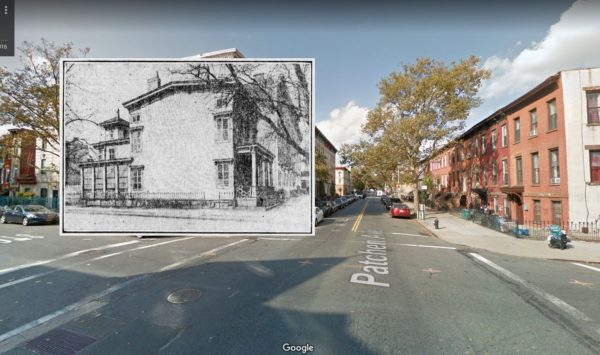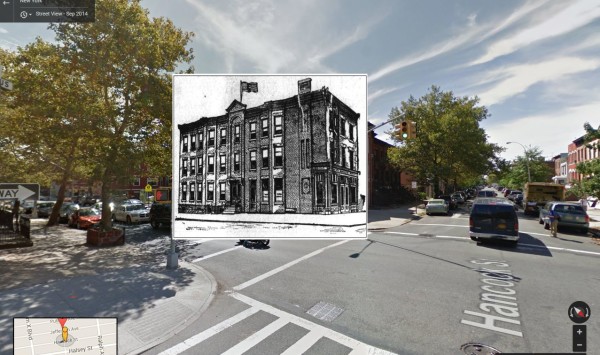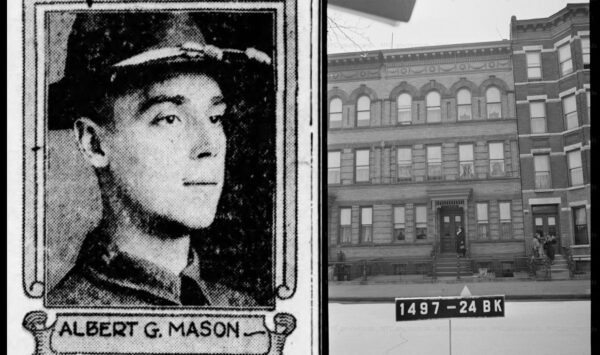SUNSETTING ON A BED-STUY BOULEVARD (1909)

******************************************************************************************************************************** Brownstone Detectives investigates the history of our clients’ homes. The story you are about to read was composed from research conducted in the course of one of those investigations. Do you know the history of YOUR house? ******************************************************************************************************************************** In 1909, a landmark was about to be destroyed. It was quite common, though, at the time for owners to tear down the antiquated wood-frame mansions that dotted Brooklyn’s lamdscape. Since the new brownstone houses had become all the rage in the 1880s, these tinder “firetraps” had become redundant, difficult to sell, and simply unstylish to live in. By the late 19th century, they were being sold, in many cases, for the value of their land as building lots. And with the demise of these historical artifacts, went some truly beautiful examples of mid-19th century architecture, few of which remain with us to this day. THE DE MILLE HOUSE The De Mille house was built around the middle of the 19th century for the family of that name, “and it has been a landmark in that region since the days when it was surrounded by open fields.” Yes, even Bedford-Stuyvesant – today chockablock with brownstone and masonry homes – was once – even before the advent of wood-frame homes – forested land alongside open virgin fields. As a matter of fact, the corner of Quincy and Patchen, in the 1850s, was little more than hills, dales, dirt lanes, and the vague promise of a future suburban city. “Broadway, which is nearby, […]
THE MISSING CORNERS OF BED-STUY (1941)

******************************************************************************************************************************** Brownstone Detectives investigates the history of our clients’ homes. The story you are about to read was composed from research conducted in the course of one of those investigations. Do you know the history of YOUR house? ******************************************************************************************************************************** So many of our corner buildings are missing. If you walk around any neighborhood that was built-up in the late 19th/early 20th century, you’ll find that many of these “end-lot” buildings did not survive the “down” periods of Brooklyn history. Compared to their smaller 1- and 2-family homes that have historically surrounded them, these larger apartment buildings have had a much more difficult time staying maintained and holding on to their tenants. Largely due to costs, the maintenance and upkeep has gone first, followed by the disappearance of the tenants – then the buildings themselves. Many of these buildings have been torn down, actually, since the 1980s – some as recently as 7-10 years ago. Sadly, we even see “tear-down” candidates which have surprisingly lasted into the present century – those buildings which, to a builder, would be cheaper to tear down than to renovate. If you want to see what these old “disappeared” apartment buildings look like, there is a deteriorating example that sits today at the corner of Malcolm X Boulevard and Macon Street. This one is already on the auction block and, sadly, will struggle to survive into the next decade. THE LOTS OF BED-STUY One Brooklyn neighborhood where empty corner lots abound is Bedford-Stuyvesant. These lots tell […]
CPL. ALBERT G. MASON (A BEDSTUY HERO)

******************************************************************************************************************************** Brownstone Detectives investigates the history of our clients’ homes. The story you are about to read was composed from research conducted in the course of one of those investigations. Do you know the history of YOUR house? ******************************************************************************************************************************** In 2014, The Brownstone Detectives partnered with the New York City Parks Department to help celebrate the lives of the servicemembers of Bedford-Stuyvesant Heights who made the ultimate sacrifice during the Great War. We researched these heroes to locate pictures, stories, and their descendants to be brought together for a ceremony that dedicated a new “Victory and Peace” war memorial at Saratoga Park. This biography tells the story of one of those servicemembers. CORPORAL ALBERT G. MASON Born in the Stuyvesant section on 3 April 1893, Albert G. Mason was the son of Mrs. Minnie Clifford Mason. Although he grew up at 591 Bainbridge and 798 Macon Street, his mother was living at 117 Patchen Avenue during the war. Mason was a member of the 47th Infantry Regiment, 4th Infantry Division, and had been in the Army for seven years before the U.S. got involved in WWI. He had served at that point from the Philippines to Texas to Mexico, but soon would find himself in another more dangerous theatre of war. On May 25th, 1918, Mason’s regiment landed at Brest in France. Two months were spent training with British and French units before July 27th, when “the Raiders” (the nickname of the 47th) were marching knee deep in mud to […]